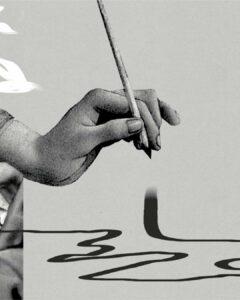
Visiting one post-Soviet state, you can then recognize it in all others – the similar patterns of urban planning and the identical buildings, structures, roads, pipes, wires, tiles, etc. However, an outsider delving inside under the extreme familiarity of the material environment finds an extreme “strangeness” of social interactions and practices. The “Outside In” series is about emplaced paradoxes and nuances. It spotlights the mundane in Armenia’s peripheral locations, where the seemingly unspectacular encounters with people and things allowing us to capture the unique features of the territory.
Listen to the article.
Outside In
Essay 20
Carefully choreographed national pavilions at art, design and architecture biennales, triennales, and similar cultural gatherings are more than mere display spaces. They constitute a form of soft diplomacy where nations mobilize ideas, aesthetics and visions of the future built environment. The national pavilion system is a subtle battleground of cultural supremacy, where each structure becomes a physical manifestation of how a country wishes to be perceived on the global stage. This competitive framework inherently shapes the very nature of architectural discourse, often prioritizing spectacle over critical examination or collaborative exploration.
Though I rarely enjoy the performative nationalism often on display at cultural and sporting events, this year I embarked, more out of curiosity than enthusiasm, to visit the Armenian pavilions at two concurrent exhibitions: the Triennale Milano themed “Inequalities” and the Venice Biennale of Architecture titled “Intelligence. Natural. Artificial. Collective.” What I saw was distinctly dissimilar approaches and ideas. Yet, both pavilions in their own respect raised the questions of authenticity, (in)significance, and humanity of built forms. What follows is my humble outsider’s review, both in terms of nationality and professional identity. My praise and criticism stem from genuine affect, while editorial opinions may differ from those presented in the essay.
Heritage and AI Bugs: The Armenian Pavilion at the Venice Biennale of Architecture
As the pavilion’s overseer kindly explained, the Armenian pavilion at the Venice Biennale of Architecture, commissioned by the Ministry of Education, Science, Culture, and Sports and titled “Microarchitecture Through AI: Making New Memories with Ancient Monuments” attempts to bring attention to the challenges facing cultural heritage today. The interdisciplinary project, curated by Marianna Karapetyan of Electric Architects, addresses the loss of heritage while exploring how contemporary technologies may offer new methods for preservation and reinterpretation. At the core of the exhibition are AI generated compositions—columns, khachkars, portals—carved in tuff and inspired by the digitized archive of Armenian architectural sites developed by TUMO’s Armenian Heritage Scanning Project.
In a vast, voluminous, dimly lit space of old red brick, the centerpiece is a cubic structure of metal and plastic. To be more specific, metal beams with strips of rubber material resembling curtains, which obscure the main exhibit, create a theatrical threshold. The transition from the venue’s atmospheric gloom to the pavilion’s clinical brightness is jarring, though perhaps the stark cold illumination serves its own curatorial purpose.
At first glance, the pavilion’s content seemed like another reference to the renowned—though increasingly overused—motifs of medieval Armenian architecture. With all due respect for its ancient grandeur, constant recycling of these themes risks becoming a kind of reverent cliche. However, a closer look revealed something more intriguing. The details of these seemingly familiar forms were, in fact, quite remarkable. They were forms that resisted easy classification.
The pavilion’s engagement with heritage preservation deserves serious consideration, particularly given the urgent contexts of conflict and cultural erasure affecting Armenian cultural sites. In keeping with the Biennale’s thematic framework, the approach here combines the ostensibly “natural” (tuff stone, architectural archives) with the decidedly artificial (AI-generated imagery) resulting in a collective endeavor of post-truth intelligence. An appeal to emotions, identity, and loyalty rather than a rigorous factual presentation.
The seminal essays of German philosopher Walter Benjamin “The Work of Art in the Age of Mechanical Reproduction” and “On the Mimetic Faculty” offer a useful lens for engaging with the content of the pavilion. Benjamin argued that reproduction inevitably diminishes art’s “aura,” i.e. its unique presence and authenticity. The Armenian pavilion ventures into even more complex territory. The exhibits are not merely reproductions but AI-generated interpretations that bear the hallmarks and bugs of algorithmic processing. Crooked lines and weird forms, sloppy slabs, unidentifiable scribble—authentic details heavily processed by AI. Where Benjamin warned about the loss of aura through mechanical reproduction, might we ask what happens when the reproduction itself becomes a kind of speculation upon the original? What (if anything) is being lost as the genuine human-made chains of concordance are distorted through the snap of the machine?
The tactile dimension proves particularly revealing:
- Touch the surface, can you feel the circle under the portal? The pavilion’s overseer invited us to tactically explore the exhibits.
- Circle? No, this does not feel like a circle or sphere. More like a tumor…
The surfaces lack the aesthetics and texture we come to associate with Armenia’s architectural heritage. Instead, one finds themselves touching what feels distinctly…synthetic? This experience raises questions about the relationship between digital interpretation and physical sensation—about the violence of representation born from mimetically capacious algorithms. What another German philosopher, Theodor Adorno, might have recognized as a tension between technological rationality and humanity of cultural memory embedded in artefacts.
The pavilion succeeds, inadvertently perhaps, in demonstrating that questions of authenticity in the digital age are far from settled. While it may not achieve its apparent aim of seamlessly bridging medieval heritage with contemporary technology, it does offer something rather interesting: a glimpse into the uncanny valley of what might be termed, for lack of a better word, post-human art. Perhaps, AI bugs and hallucinations were the whole point. However, whether this constitutes an example of successful contemporary art/architecture or is simply an instructive cautionary tale remains, shall we say, delightfully open to interpretation.
Praise of the “Ordinary”: The Armenian Pavilion at Triennale Milano
In contrast to the preoccupations with Armenia’s “monumental” heritage sites that dominated the Biennale discourse, the Armenian pavilion at the Triennale Milano shifts attention to the everyday, the overlooked, what the curators from the Library for Architecture (LfA) term “ordinary” architecture. This curatorial gesture extends, perhaps unintentionally, the conceptual lineage of the 2016 Armenian pavilion at the Venice Biennale of Architecture, “Independent Landscape,” curated by Sarhat Petrosyan. In particular, its exploration of expanded housing and variations of outbuildings in courtyards.
The pavilion materializes as a replica of the ubiquitous (post)-Soviet garage. In Yerevan, these structures undergo constant metamorphosis at the hands of their owners and tenants, transforming them into sites of commerce, sociability and creative production. They house everything except, paradoxically, cars: workshops and boutiques, offices and beauty parlors, cafes and galleries. Once concealed and marginal, garages in Yerevan are emerging as porous micropublic spaces and sought-after sites for creatives and the urban middle class.
The garage here emerges not merely as an architectural form, but functions as a heuristic device for interrogating the mythology of entrepreneurship and radical individualism of Yerevan’s built environment. And while the garage-as-exhibition-space hardly constitutes a novel intervention even in Armenia, it nonetheless offers a compelling meditation on the often-overlooked architectural typologies.
Within the pavilion’s modest 20 square meters, over 20 contributions from Armenia-based architects, designers, and interdisciplinary practitioners find accommodation. These include works by the LfA founders as well as responses to their open call. This eclectic assembly celebrates the prosaic structures and the mundane, the Heideggerian “ready-to-hand” objects. Being essential they recede into the background of consideration due to familiarity and accessibility.
While certain exhibits proved more compelling than others, the collective endeavor succeeds in illuminating the significance of the seemingly insignificant material forms. My personal favorite was the perhaps spontaneous dialogue between Shant Charoian’s “Pipes, Pipes, Pipes” and Storaket Architectural Studio’s “Thresholds,” an assemblage that emerges organically from spatial proximity.
“Thresholds” is 90 square centimeters of diverse ceramic tiles, a modest intervention that nonetheless gestures toward the micropolitics governing the demarcation between public and private domains. The work references the widespread practice of neighbors asserting territorial claims through strategic tiling around their apartments, a phenomenon readily observable in any residential stairwell in Yerevan. Directly above this reflection on boundaries, Charoian’s “Pipes, Pipes, Pipes” serves as an immediate reminder of our inescapable interconnectedness through infrastructural networks. Here lies a profound tension: despite our persistent aspirations toward individualization, we remain inexorably bound through the most mundane flows, such as gas, electricity and water. These works collectively manifest what social anthropologist Brian Larkin referred to as the politics and poetics of infrastructure, the material entanglements that constitute us as irreducibly collective beings, whether we acknowledge them or not.
See all [Outside In] articles here

Maria Gunko is a DPhil Candidate in Migration Studies, Hill Foundation Scholar at the School of Anthropology and Museum Ethnography University of Oxford. Since 2023, she has joined Yerevan State University as a Visiting Professor. Maria holds an MSc and Kandidat Nauk (Russian post-graduate degree) in Human Geography.
Maria’s research interests lie in the intersection of urban studies and social anthropology, including ethnography of the state, infrastructures, and urban decay with a geographical focus on Eastern Europe and the Southern Caucasus. She is the co-editor of one monograph, author of over thirty scientific articles and op-eds.

